Green tea in Chinese medicine (TCM) has been valued for thousands of years, not just as a refreshing drink but as a powerful healing herb. From balancing yin and yang to supporting digestion, focus, and longevity, green tea has always played a vital role in wellness. Today, modern science confirms much of what ancient healers already knew.
Ready to experience the healing power of Green Tea in Chinese Medicine? 🌿 Explore more wellness secrets on our blog, or start your own journey by adding this ancient remedy to your daily routine today!
Green Tea in Chinese Medicine: Ancient Healing in a Modern Cup
1. Introduction
Green tea isn’t just a soothing drink we sip on—it’s a cornerstone of Green Tea in Chinese Medicine, celebrated for its healing and balancing properties for thousands of years.. In Traditional Chinese Medicine (TCM), green tea is much more than a beverage; it’s considered a healing herb that restores balance, strengthens the body, and sharpens the mind. Today, while millions enjoy green tea for its refreshing taste or weight-loss reputation, its roots in ancient Chinese healing remind us that every sip connects us to centuries of wisdom.
If you’ve ever wondered why green tea is often called “the elixir of life,” the answer lies in how Chinese medicine used it not just to quench thirst but to rebalance energy (qi) and promote longevity.
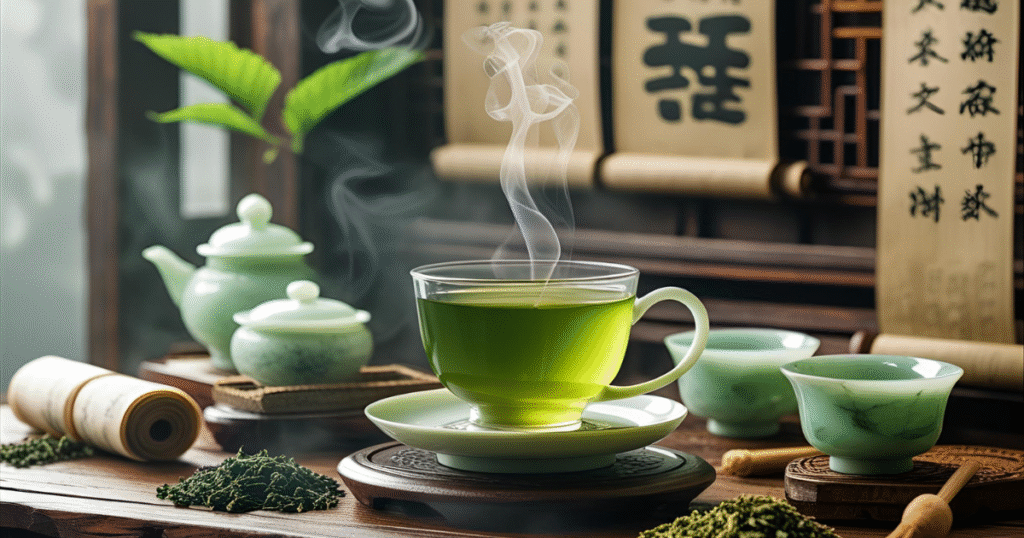
2.The Origins of Green Tea in Traditional Chinese :
The story of Green Tea in Chinese Medicine begins in ancient China, more than 4,000 years ago. According to legend, Emperor Shennong, the “Divine Farmer,” discovered tea when leaves accidentally fell into his pot of boiling water. Fascinated by its taste and invigorating qualities, Shennong began documenting its effects. His classic herbal text, the Shennong Ben Cao Jing (The Divine Farmer’s Materia Medica, ~200 BCE), included green tea as both a medicine and beverage.
During these early times, green tea in Chiniese wasn’t consumed for leisure. It was brewed as a remedy for fatigue, indigestion, and “heat” in the body. Monks later adopted green tea as a tool for meditation, believing it calmed the spirit and sharpened concentration. This dual role—spiritual and medicinal—set the foundation for its lasting importance.
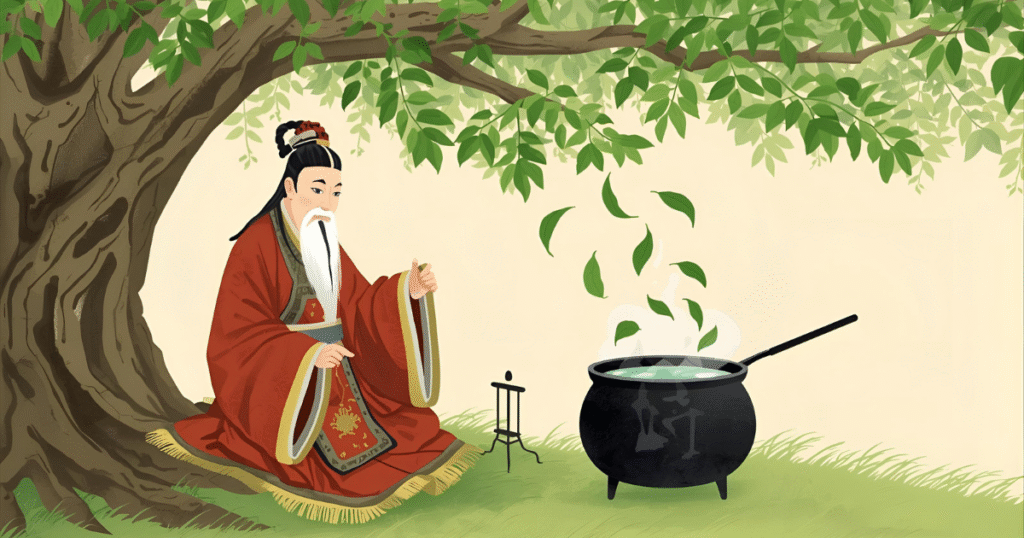
3. Green Tea in Traditional Chinese Medicine (TCM) Philosophy
TCM Philosophy of Green Tea: Ancient Wisdom in Healing
In Traditional Chinese Medicine (TCM), every food and herb plays a role in wellness. Green Tea in Chinese Medicine is especially revered for its cooling, calming, and mind-sharpening effects.
Green tea, with its cooling nature, has always been seen as a tool for restoring harmony.
Cooling Nature of Green Tea in Chinese Medicine
According to TCM theory, green tea is classified as cooling (yin), slightly bitter, and mildly sweet.
This unique profile means it can:
- Clear heat → calming inflammation, fevers, or excess body heat.
- Aid digestion → bitterness reduces “dampness,” TCM’s concept for sluggish digestion.
- Sharpen the mind → its qi (vital energy) lifts mental fog and boosts alertness.
Green Tea for Mind-Body Connection
But the power of green tea isn’t only physical.
In TCM, the mind and body are deeply connected.
Drinking green tea in CHINIESE was believed to balance emotions, reduce irritability, and encourage a calm but alert state.
This is why monks often drank it before meditation—it kept them awake without the agitation of stronger stimulants.
Storytelling – Green Tea as a Ritual of Clarity
✨ Storytelling Moment:
Imagine a scholar in ancient China, seated by a window with calligraphy scrolls, sipping a delicate infusion.
For him, tea wasn’t just a drink—it was a ritual of clarity and focus, aligning his energy with balance and mindfulness.
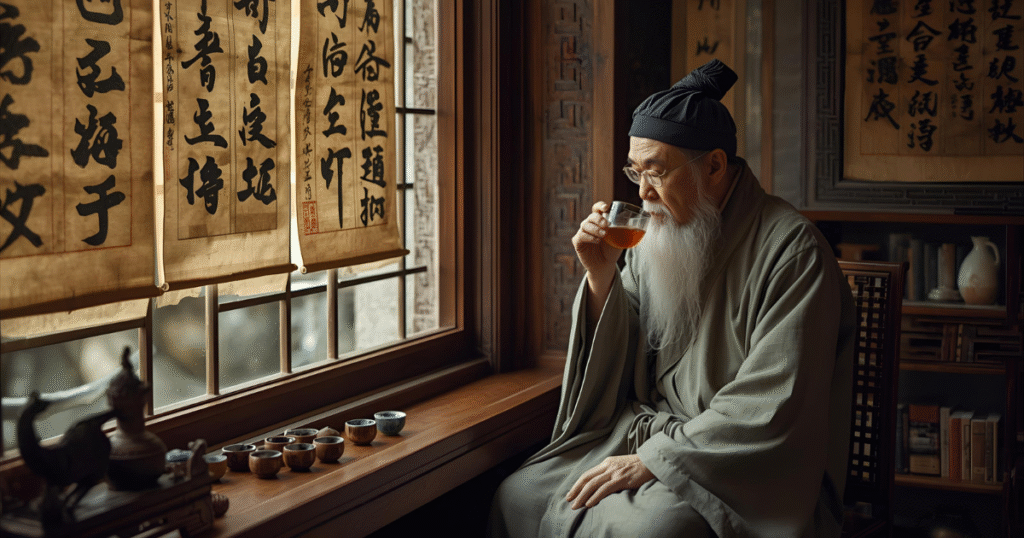
Modern Science Meets Ancient TCM
Modern science now echoes some of these ancient beliefs.
The amino acid L-theanine in green tea promotes relaxation, while caffeine enhances alertness.
Together, they create a calm yet focused energy.
It’s fascinating to see how TCM’s centuries-old wisdom aligns with today’s biochemical discoveries.
Green Tea as a Harmonizer in TCM
So, in the philosophy of Chinese medicine, green tea is not just hydration.
It is a harmonizer—a gentle medicine that works with the body’s rhythms.
It helps in balancing heat, calming the spirit, and sharpening awareness.
So, in the philosophy of green tea in Chinese medicine, this humble drink is more than hydration.
It is a harmonizer, gently balancing heat, calming the spirit, and sharpening awareness.
That’s why TCM green tea benefits remain just as relevant today as they were in ancient times.
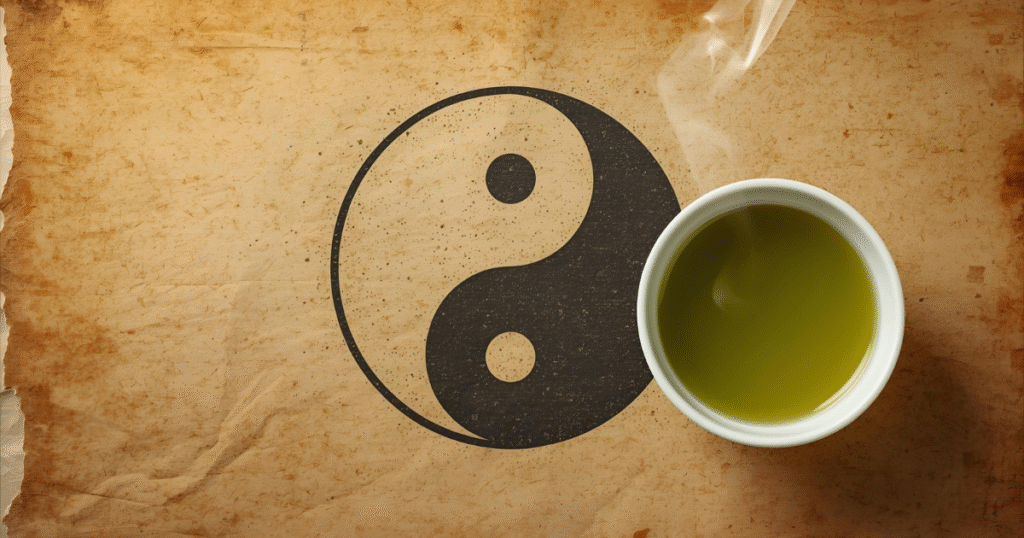
4. Medicinal Uses of Green Tea in Chinese Medicine
From dynasty to dynasty, green tea’s role in medicine continued to grow.
🍵 Medicinal Uses Through History
The reputation of Green Tea in Chinese Medicine as a healing drink grew steadily across Chinese dynasties.. Far beyond being a casual refreshment, it became a medicinal companion to emperors, monks, and scholars alike. Every dynasty added its own interpretation, shaping how green tea was valued for health and wisdom.
🌸 Tang Dynasty (618–907 CE): Tea as Medicine and Daily Comfort
The Tang Dynasty marked the first golden age of tea culture. Physicians of this era often prescribed green tea to aid digestion after the heavy, meat-rich meals popular in Tang courts.
Tang doctors believed tea cleared the head and eyes, sharpened focus, and helped regulate the body’s balance of heat and dampness.
Tea also became a household remedy—used for everything from headaches to mild fevers.
👉 Picture this: a bustling Tang marketplace, merchants carrying silk and spices, pausing at tea houses for a warm cup that refreshed the body after long journeys. Tea wasn’t luxury alone—it was medicine for travelers and scholars alike.
📜 Song Dynasty (960–1279 CE): Tea for Alertness and Study
The Song Dynasty is famous for its elegant tea ceremonies and powdered tea whisked into frothy bowls. Scholars and poets celebrated tea not just as a drink, but as a source of alertness.
Physicians noted green tea’s ability to stimulate the mind, making it popular among students preparing for the rigorous imperial examinations.
Monks also embraced tea for meditation practice, as its gentle stimulation kept drowsiness away during long hours of chanting and mindfulness.
👉 Imagine a dimly lit monastery, monks quietly sipping tea before dawn prayers. The warmth of green tea carried them through silent meditation, their minds calm yet awake.

📖 Ming Dynasty (1368–1644 CE): Tea for Clarity and Longevity
During the Ming period, tea preparation changed—loose leaf brewing replaced powdered tea, highlighting the natural flavors of green tea. Scholars of this time saw tea as more than refreshment; it was tied to mental clarity, focus, and even spiritual purity.
Ming physicians recommended tea for detoxification and maintaining longevity.
Scholars believed tea calmed the emotions, making it ideal for long nights of study, writing poetry, or engaging in intellectual debates.
👉 Envision a Ming scholar, scrolls spread across his desk, sipping slowly from a porcelain cup. Each sip of green tea wasn’t just a beverage—it was a tool for clear thinking and balanced spirit.
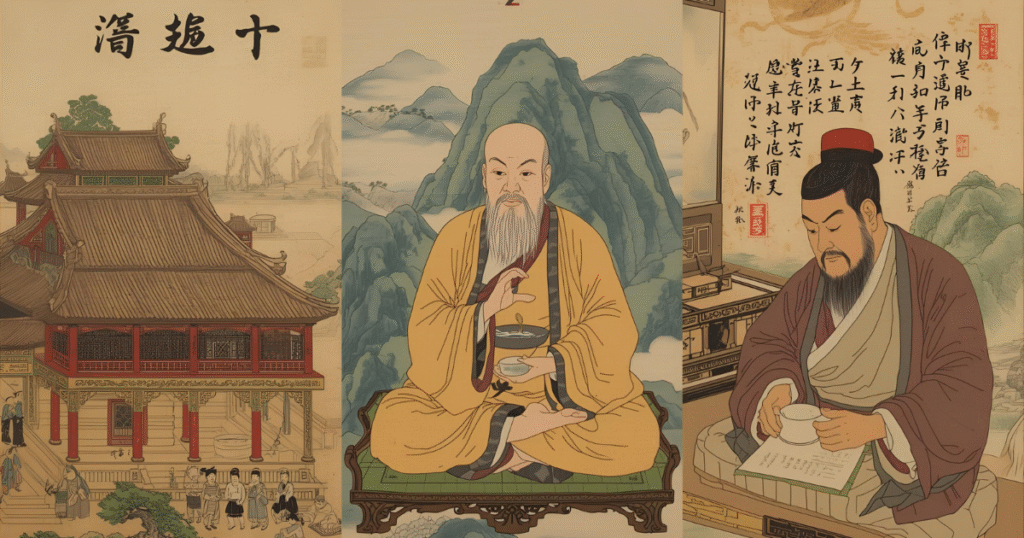
🌿 Legacy of Medicinal Tea
Through each dynasty, green tea was seen as more than just hydration—it was a daily prescription for health, intellect, and emotional harmony. This legacy continues today, where both traditional Chinese medicine and modern science recognize its benefits for digestion, alertness, and longevity.
5. Modern Science Meets Tradition
The benefits of Green Tea in Chinese Medicine, observed by ancient doctors, are now confirmed by modern science. Green tea contains powerful compounds such as:
Polyphenols & Catechins (especially EGCG): These act as antioxidants, protecting cells from damage.
L-Theanine: An amino acid that promotes relaxation without drowsiness.
Caffeine (in small amounts): Provides gentle stimulation without the crash of coffee.
Health benefits confirmed by research:
- Supports heart health by reducing cholesterol.
- Boosts metabolism and aids weight management.
- Improves gut health by supporting beneficial bacteria.
- Enhances brain function and concentration.
- Reduces inflammation, echoing its “heat-clearing” role in TCM.
Essentially, science validates what TCM has taught for centuries: green tea heals, balances, and protects.
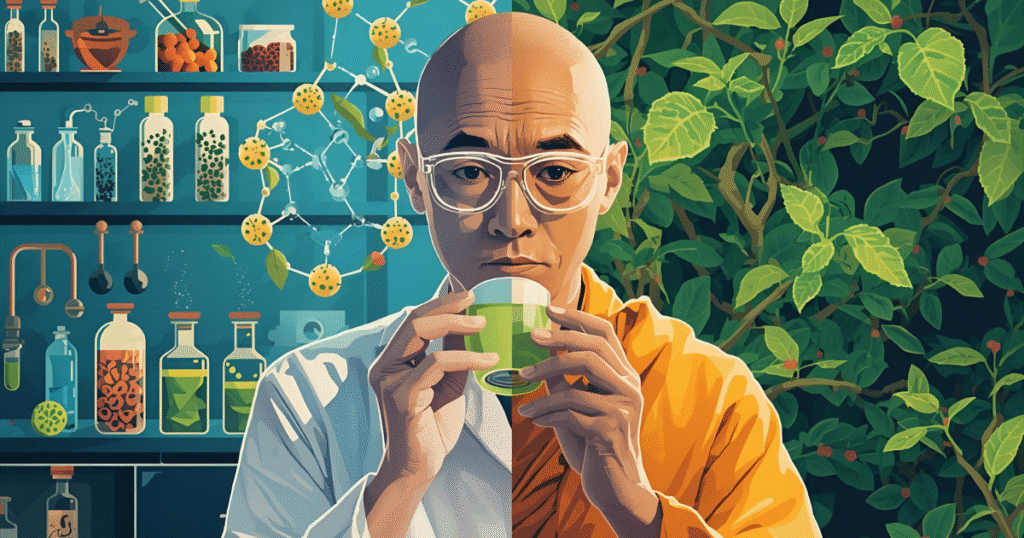
6. Green Tea in Daily Rituals & Lifestyle
☯️ Green Tea in Rituals and Daily Life in China
Green Tea in Chinese Medicine wasn’t just medicine—it was woven into the social and cultural fabric of China. Over thousands of years, it shaped daily routines, religious practices, and social etiquette. From sacred rituals to family gatherings, tea became a symbol of respect, mindfulness, and connection.
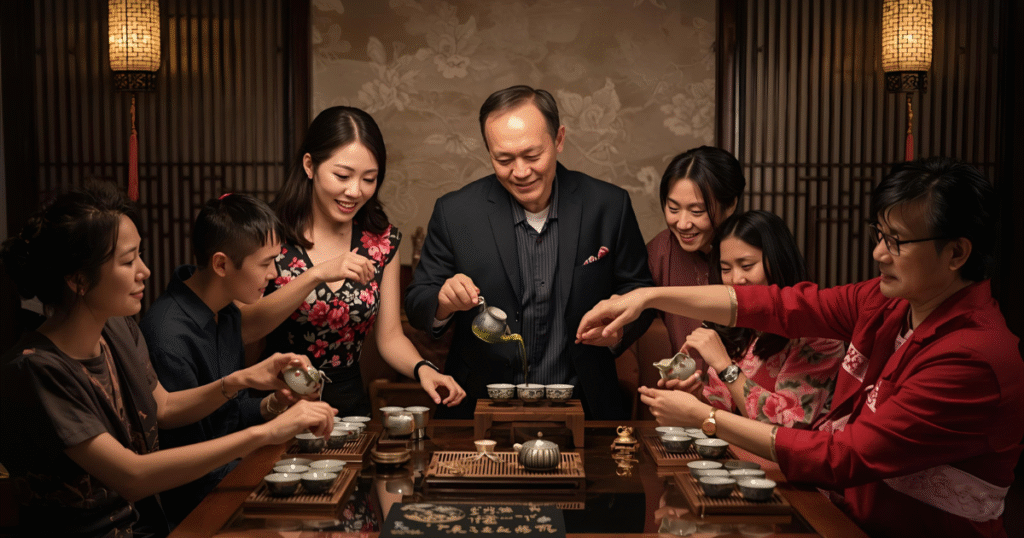
🏯 Tea in Monastic Rituals
In Buddhist monasteries, green tea played an essential role.
- Monks drank tea before meditation sessions to stay alert without disturbing their inner calm.
- Offering tea to guests symbolized purity and respect, making it a ritual of hospitality.
During Zen practices, tea was more than refreshment—it was a form of spiritual mindfulness, connecting body and spirit in harmony.
👉 Picture a quiet temple courtyard in the Song Dynasty, monks pouring steaming cups of green tea for visitors. The act wasn’t casual—it was a silent ritual of honor and presence.
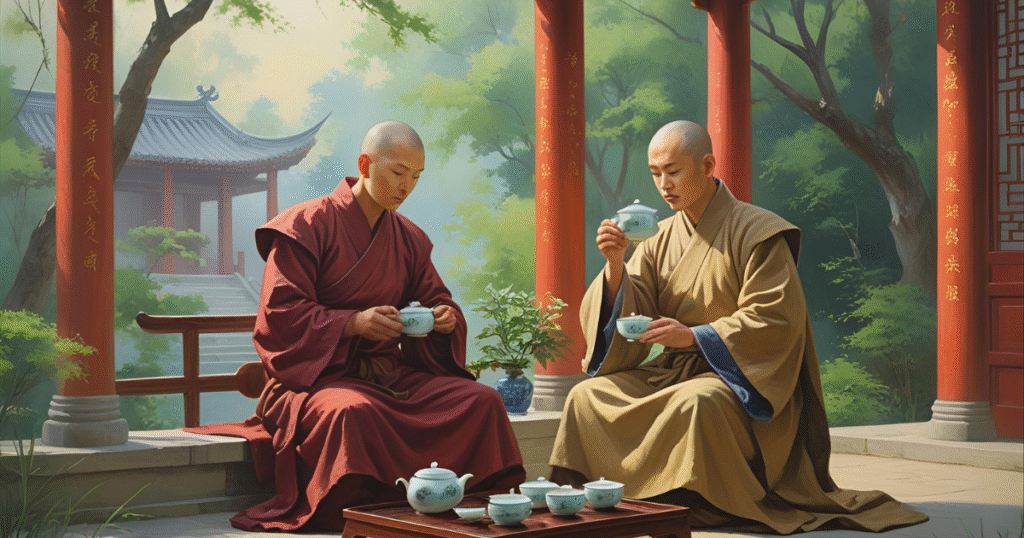
👨👩👧👦 Tea in Family Life and Hospitality
Tea became deeply tied to Chinese daily life and traditions:
- Serving tea to parents or elders showed filial respect, a Confucian value still practiced today.
- Families shared tea during meals, seeing it as both refreshing and cleansing.
- In weddings, brides often serve tea to in-laws, a symbolic gesture of acceptance and unity.
👉 Imagine a wedding ceremony in ancient China: the bride kneeling gracefully, offering tea to her new family, sealing bonds with a humble yet powerful gesture.
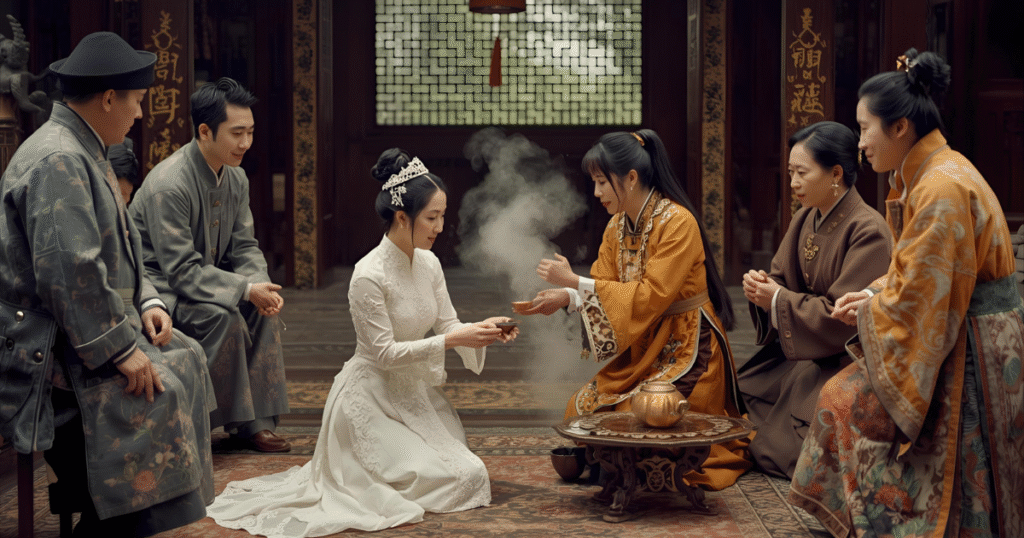
🎎 Tea Houses and Social Life
By the Tang and Song dynasties, tea houses emerged as cultural hubs.
- Merchants, scholars, and travelers gathered to share tea, exchange news, and debate ideas.
- Tea houses weren’t just businesses—they were centers of community life, much like coffee shops today.
- In cities like Chengdu and Hangzhou, tea houses became symbols of leisure and intellectual exchange.
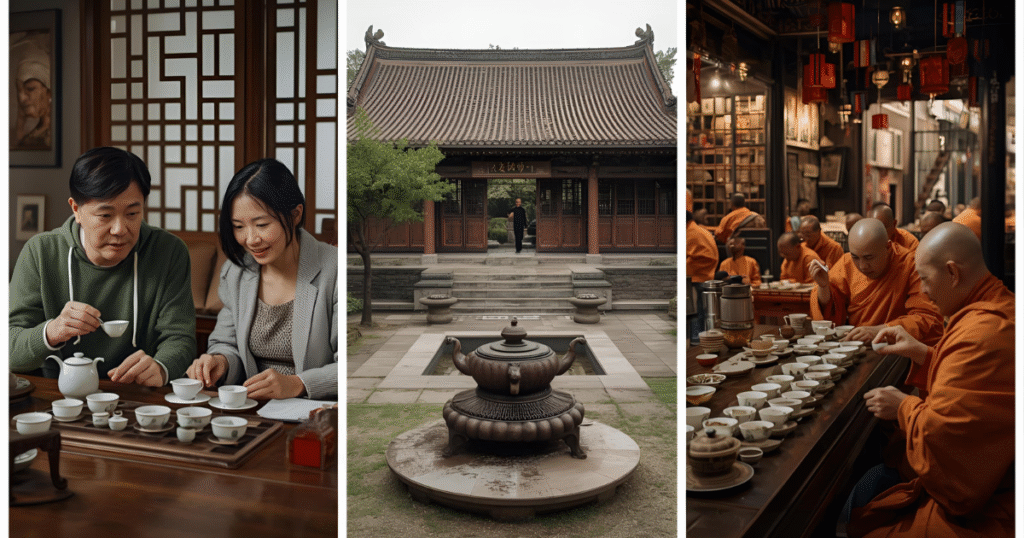
👉 Envision a lively Song-era tea house: poets reciting verses, merchants striking deals, and musicians entertaining—all fueled by the calming yet stimulating presence of green tea.
🌿 Green Tea as Symbol and Tradition
Over time, green tea became a symbol of simplicity, purity, and respect. It was:
- A gift of honor to guests.
- A spiritual tool in temples.
- A daily ritual in homes across China.
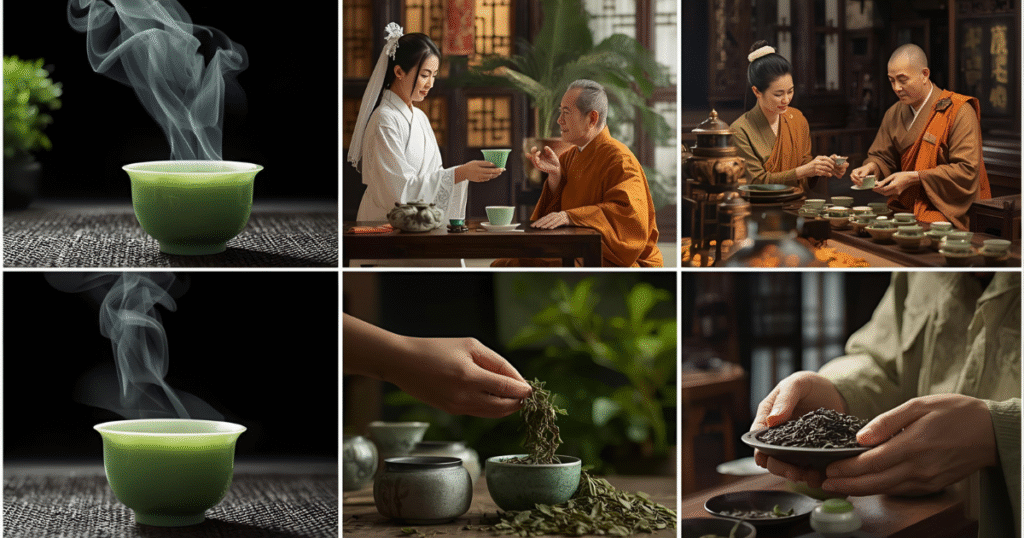
This balance of sacred ritual and ordinary life is what makes green tea unique—it is both extraordinary and everyday, celebrated for centuries as a drink of health, respect, and connection.
7. Popular Green Tea Varieties in TCM
In Traditional Chinese Medicine, the role of Green Tea in Chinese Medicine varied across different teas and regions. Different regions of China produced unique green tea varieties, each with its own flavor, energy (qi), and healing effects. Physicians, monks, and scholars often recommended specific teas depending on a person’s health needs or environment.
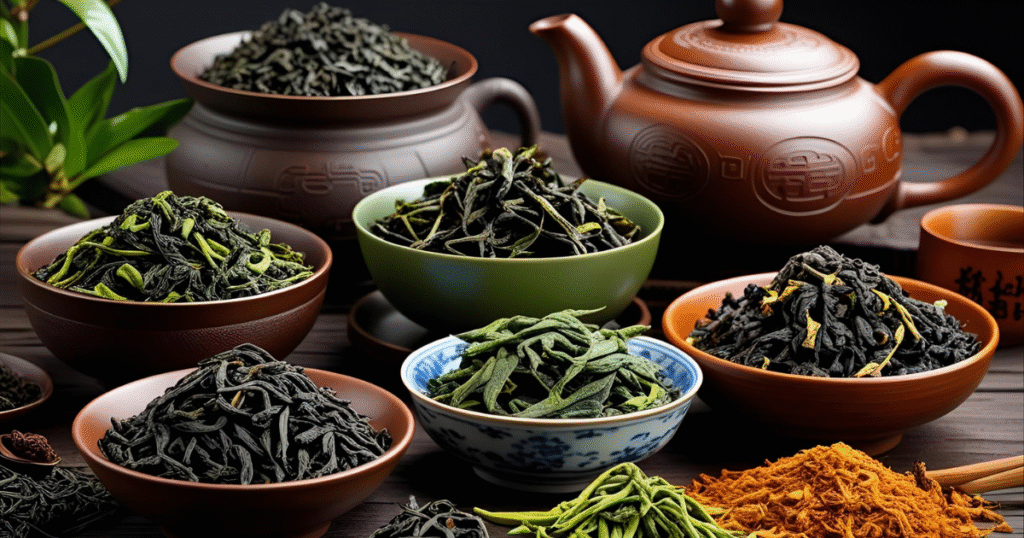
🌱 1. Longjing (Dragon Well Tea) – The “Cooling Elixir”
Originating from Hangzhou, Zhejiang Province, Longjing is one of the most famous green teas.
In TCM, it is considered a “cooling” tea, perfect for balancing excess body heat.
Benefits:
- Clears toxins from the body.
- Eases thirst and dry throat.
- Supports digestion after rich meals.
Storytelling: Imagine an imperial scholar during the Song Dynasty, sipping Longjing before an exam to calm his nerves and sharpen his focus.
🌿 2. Bi Luo Chun – The “Spring Spiral” for Refreshment
Grown near Dongting Lake, this tea is harvested early in spring.
In TCM, Bi Luo Chun is seen as a refreshing, cleansing tea.
Benefits:
- Improves metabolism.
- Removes “dampness” from the body.
- Boosts energy and clarity without overstimulation.
Storytelling: Farmers in the Ming Dynasty drank Bi Luo Chun during long spring planting days, believing it restored energy and prevented fatigue.
🍃 3. Huangshan Maofeng – The Gentle Healer
From the misty Yellow Mountains (Huangshan), this tea is delicate and aromatic.
In TCM, it’s valued for being gentle on the stomach.
Benefits:
- Soothes digestion.
- Reduces inflammation.
- Improves circulation and relaxation.
Storytelling: Monks in mountain temples brewed Huangshan Maofeng for meditation, believing its light energy aligned with spiritual balance.
🍂 4. Lu’an Melon Seed Tea – The Protector of Qi
Named for its melon-seed-shaped leaves, this tea comes from Anhui Province.
In TCM, it was considered a protector of qi (vital energy).
Benefits:
- Strengthens the immune system.
- Supports respiratory health.
- Boosts alertness and focus.
Storytelling: During the Qing Dynasty, soldiers carried Lu’an tea on campaigns, believing it helped them maintain stamina and endurance.
🌸 5. Jasmine Green Tea – The Balancer of Emotions
While technically scented, Jasmine green tea became highly popular in TCM.
Considered harmonizing and mood-lifting.
Benefits:
- Relieves stress and anxiety.
- Helps with digestion and bloating.
- Clears the mind for relaxation.
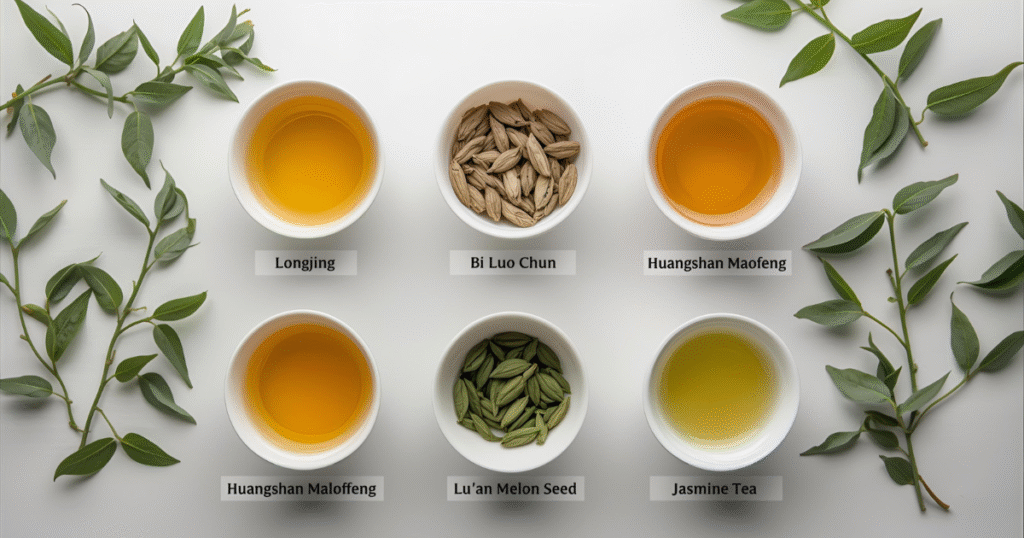
Storytelling: In the Qing Dynasty, noblewomen drank jasmine tea during gatherings, seeing it as both elegant and emotionally balancing.
Popular Green Tea Varieties in TCM
✨ “Over centuries, Chinese dynasties refined green tea into distinct varieties, each carrying not just flavor but also healing purposes in Traditional Chinese Medicine (TCM). Below is a glance at some of the most celebrated green teas and their traditional roles in promoting balance and wellness.”
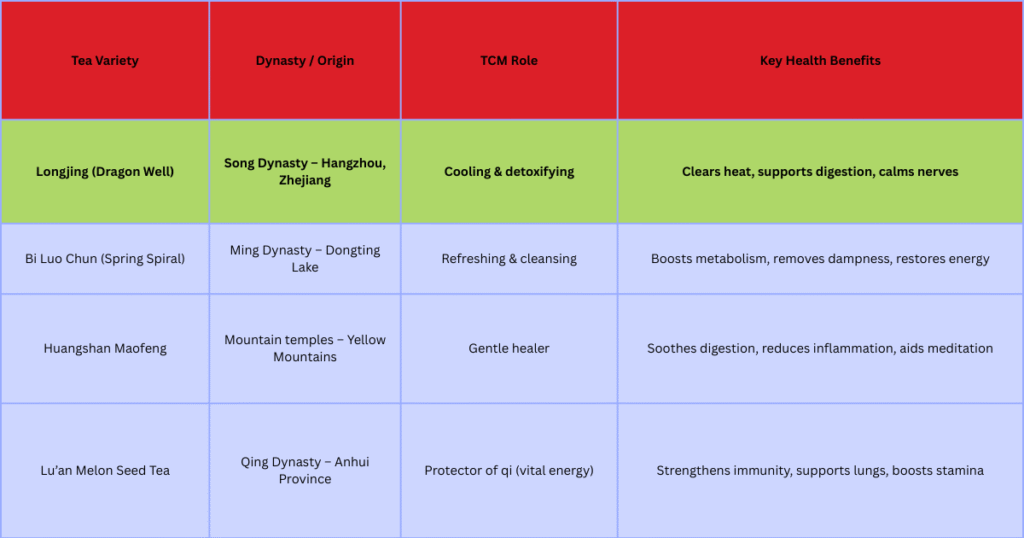
8🌿 Modern Relevance of Green Tea in Wellness & Medicine
Although green tea carries thousands of years of Chinese tradition, GREEN TEA relevance hasn’t faded — in fact, it’s more popular today than ever before. What began as a medicinal drink for emperors, scholars, and monks has now become a global wellness trend, supported by both scientific research and modern lifestyle choices.
1. Backed by Science
Modern studies show what Chinese healers already believed centuries ago: green tea supports digestion, immunity, heart health, and mental focus. Catechins (powerful antioxidants in green tea) have been linked to weight management, lower cholesterol, and anti-aging benefits. This aligns perfectly with its TCM role of “balancing the body.”
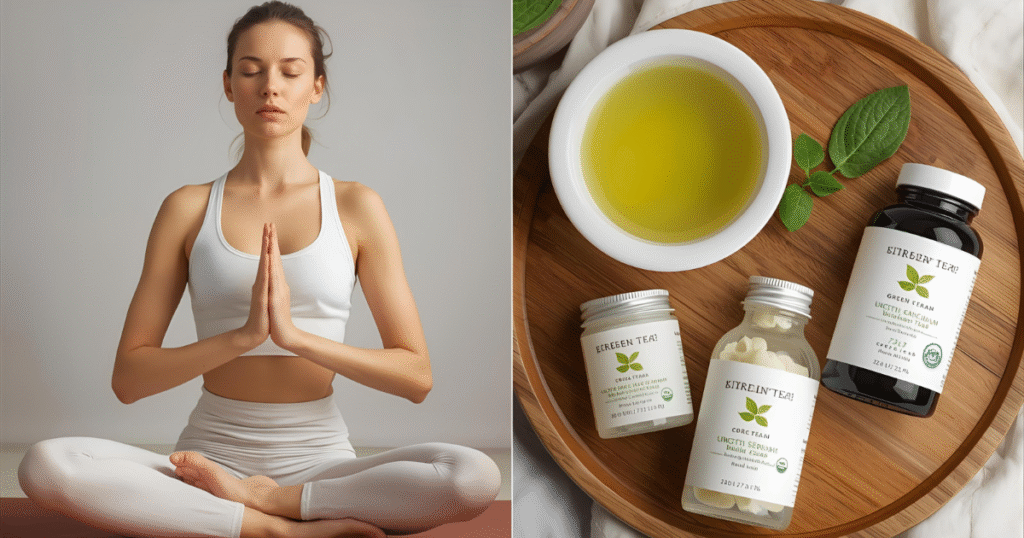
2. Green Tea in Everyday Wellness
Today, green tea is no longer reserved for temples or emperors. It’s found in:
Morning routines – as a healthier alternative to coffee.
Fitness lifestyles – as a metabolism booster and fat-burner.
Mindful eating – as a natural, calming drink that connects people with tradition.
For many, sipping green tea has become a ritual — a pause in a fast-paced day that echoes the meditative calm of ancient monks.
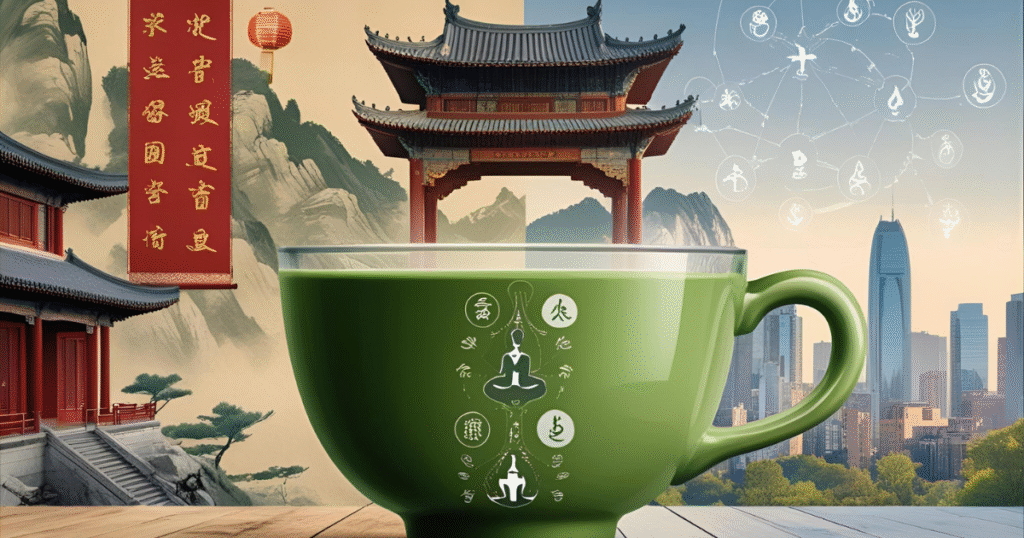
3. Beyond the Cup: Skincare & Supplements
The role of green tea has expanded beyond drinking. Modern wellness products use green tea extracts in:
Skincare – anti-aging creams, acne treatments, and natural toners.
Supplements – capsules for weight loss, energy, and stress reduction.
Functional foods – smoothies, protein powders, and even chocolates infused with green tea.
This shows how green tea evolved from a medicinal leaf to a multi-billion-dollar global wellness industry.

4. A Bridge Between Ancient & Modern Healing
What makes green tea truly special is its ability to connect the ancient wisdom of TCM with modern health science. When you sip green tea today, you’re not just drinking a beverage—you’re participating in a ritual that links past dynasties with today’s wellness culture.
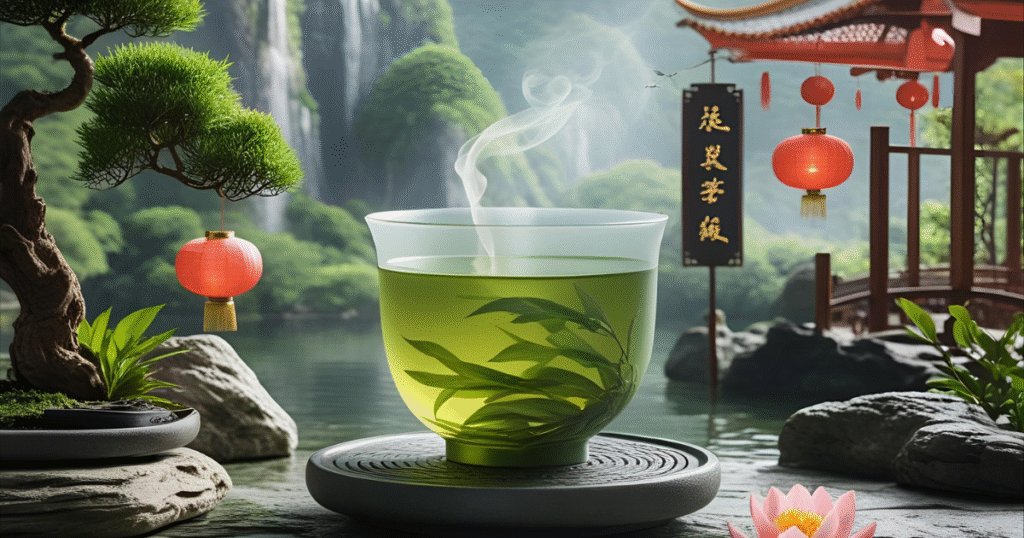
✨ It’s a reminder that sometimes, the oldest remedies still carry the most timeless wisdom
9. Conclusion
Green tea is more than just a trendy drink—it’s a 2,000-year-old healing tradition that continues to evolve. In Chinese medicine, it symbolizes balance, clarity, and longevity. In modern science, it represents antioxidants, gut health, and mental focus.
By drinking green tea, we’re not just nourishing our bodies; we’re embracing the ancient wisdom of Green Tea in Chinese Medicine, connecting with centuries of health, balance, and mindfulness.. The next time you sip green tea, remember—you’re holding a piece of ancient Chinese wisdom in your cup.
Green Tea in Chinese Medicine is more than a herbal drink — it’s a living philosophy of harmony, health, and mindfulness. Every sip connects us to centuries of wisdom and reminds us that true healing starts with balance inside and out.
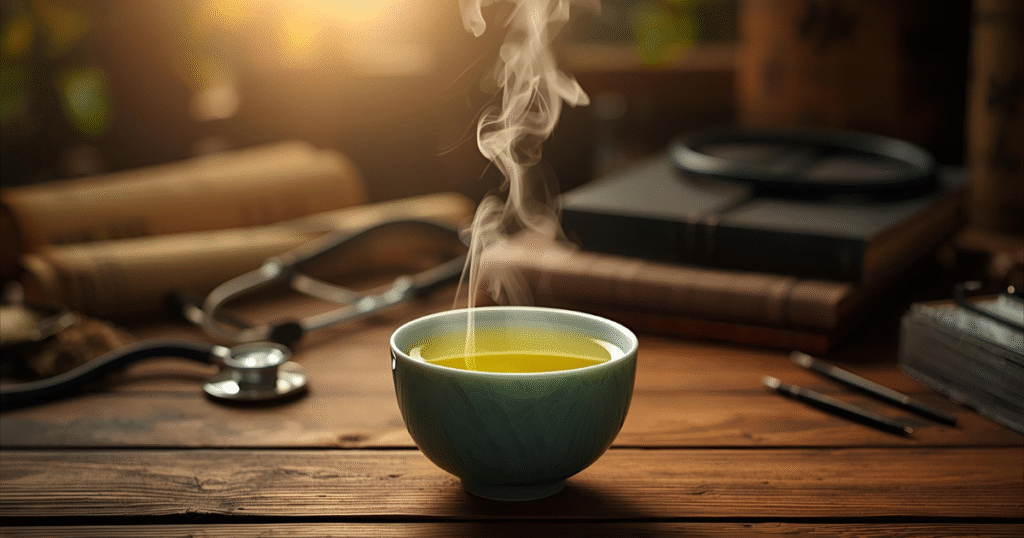
“Join thousands of readers who are unlocking the secrets of Green Tea in Chinese Medicine.
✨ Share your favorite tea ritual in the comments below and connect with mindful living!”
FAQs: Green Tea in Chinese Medicine
Q1: Is green tea used in Chinese medicine?
Yes, green tea has been used in Traditional Chinese Medicine (TCM) for over 2,000 years. It’s considered a cooling herb that clears heat, aids digestion, and sharpens mental clarity.
Q2: What are the health benefits of green tea in Chinese medicine?
Green Tea in Chinese Medicine supports digestion, reduces inflammation, boosts mental focus, balances the body’s energy (qi), and promotes longevity.
Q4: How much green tea should I drink daily according to Chinese medicine?
2–3 cups per day is ideal. Overconsumption may cause excessive cooling or digestive discomfort.
Q5: Is green tea still recommended in modern Chinese medicine practices?
Yes. Many contemporary TCM practitioners continue to recommend Green Tea in Chinese Medicine as a daily tonic for preventive health, mental clarity, and overall balance.
Q3: Can green tea balance yin and yang?
Absolutely. In TCM, green tea is classified as a yin (cooling) herb, helping to restore harmony when the body has excess yang (heat).

Pingback: 7 Fascinating Foods That Were Once Considered Medicine (Fun Food Facts)